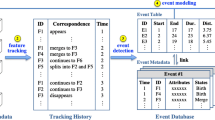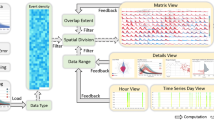Abstract
There is a large volume of spatiotemporally correlated multivariate data in multiple layers of the earth’s environmental system. Compound events arise from the interaction of multiple variables. Current approaches employed by earth scientists lack the flexibility to identify the drivers and corresponding impacts of different events. In this paper, we present MVST-SciVis (MultiVariate SpatioTemporal Scientific data Visualization), a new visual analytics prototype to help scientists explore spatiotemporal correlations among multiple variables, and analyze the drivers and influences of different compound events. MVST-SciVis provides coordinated maps, scatterplots, line charts and bar charts to support a three-level multi-granularity complex visual analysis pipeline. MVST-SciVis also provides a storyline visualization tailored for scientific data that abstracts inter-entity relationships and the driving components information of compound events. Our case studies with the data from two ecosystem circles of climate and agriculture illustrate the usefulness and effectiveness of MVST-SciVis.
Graphical abstract














Similar content being viewed by others
References
Bach B, Shi C, Heulot N, Madhyastha T, Grabowski T, Dragicevic P (2015) Time curves: folding time to visualize patterns of temporal evolution in data. IEEE Trans Vis Comput Graph 22(1):559–568
Bach B, Dragicevic P, Archambault D, Hurter C, Carpendale S (2014) A review of temporal data visualizations based on space-time cube operations. In: Eurographics conference on visualization. The Eurographics Association, https://doi.org/10.2312/eurovisstar.20141171
Bach B, Dragicevic P, Archambault D, Hurter C, Carpendale S (2017) A descriptive framework for temporal data visualizations based on generalized space-time cubes. In: Computer graphics forum, vol 36, Wiley Online Library,pp 36–61
Biswas A, Dutta S, Shen H-W, Woodring J (2013) An information-aware framework for exploring multivariate data sets. IEEE Trans Vis Comput Graph 19(12):2683–2692. https://doi.org/10.1109/TVCG.2013.133
Chatzimparmpas A, Martins RM, Kerren A (2020) t-visne: Interactive assessment and interpretation of t-sne projections. IEEE Trans Vis Comput Graph 26(8):2696–2714. https://doi.org/10.1109/TVCG.2020.2986996
Cui Z, Badam SK, Yalçin MA, Elmqvist N (2019) Datasite: proactive visual data exploration with computation of insight-based recommendations. Inf Vis 18(2):251–267
Demiralp Ç, Parthasarathy S, Haas PJ, Pedapati T (2017) Foresight: recommending visual insights. Proc VLDB Endow 10:1937–1940
Fu T-C (2011) A review on time series data mining. Eng Appl Artif Intell 24(1):164–181
Fujiwara T, Li JK, Mubarak M, Ross C, Carothers CD, Ross RB, Ma K-L (2018) A visual analytics system for optimizing the performance of large-scale networks in supercomputing systems. Vis Inform 2(1):98–110
Fujiwara T, Sakamoto N, Nonaka J, Yamamoto K, Ma K-L et al (2020) A visual analytics framework for reviewing multivariate time-series data with dimensionality reduction. IEEE Trans Vis Comput Graph 27(2):1601–1611
Fujiwara T, Chou J-K, McCullough A M, Ranganath C, Ma K-L (2017) A visual analytics system for brain functional connectivity comparison across individuals, groups, and time points. In: 2017 IEEE Pacific visualization symposium (PacificVis), IEEE, pp 250–259
Glatter M, Mollenhour C, Huang J, Gao J (2006) Scalable data servers for large multivariate volume visualization. IEEE Trans Vis Comput Graph 12:1291–8. https://doi.org/10.1109/TVCG.2006.175
Leonard M, Westra S, Phatak A, Lambert M, van den Hurk B, McInnes K, Risbey J, Schuster S, Jakob D, Stafford-Smith M (2014) A compound event framework for understanding extreme impacts. Wiley Interdiscip Rev Clim Chang 5(1):113–128
Liu X, Shen H-W (2016) Association analysis for visual exploration of multivariate scientific data sets. IEEE Trans Vis Comput Graph 22(1):955–964. https://doi.org/10.1109/TVCG.2015.2467431
Liu S, Wu Y, Wei E, Liu M, Liu Y (2013) StoryFlow: tracking the evolution of stories. IEEE Trans Vis Comput Graph 19(12):2436–2445. https://doi.org/10.1109/TVCG.2013.196
Lundberg S M, Erion GG, Lee S-I (2018) Consistent individualized feature attribution for tree ensembles. Preprint arXiv:1802.03888
Lundberg S M, Lee S-I (2017) A unified approach to interpreting model predictions. Advances in neural information processing systems, 30
Reichert G, Pieras M, Marroquim R, Vilanova A (2021) Stabilization and visual analysis of video-recorded sailing sessions. Vis Comput Ind Biomed Art 4:12. https://doi.org/10.1186/s42492-021-00093-x
Ribeiro MT, Singh S, Guestrin C (2016) “Why should I trust you?”: Explaining the predictions of any classifier. InL Proceedings of the 22nd ACM SIGKDD international conference on knowledge discovery and data mining, KDD, vol 16, Association for Computing Machinery, New York, NY, USA, pp 1135–1144. https://doi.org/10.1145/2939672.2939778
Shepherd TG, Boyd E, Calel RA, Chapman SC, Dessai S, Dima-West IM, Fowler HJ, James R, Maraun D, Martius O et al (2018) Storylines: an alternative approach to representing uncertainty in physical aspects of climate change. Clim Chang 151(3):555–571
Shi Y, Bryan C, Bhamidipati S, Zhao Y, Zhang Y, Ma K-L (2018) Meetingvis: Visual narratives to assist in recalling meeting context and content. IEEE Trans Vis Comput Graph 24(6):1918–1929
Sillmann J, Shepherd TG, van den Hurk B, Hazeleger W, Martius O, Slingo J, Zscheischler J (2021) Event-based storylines to address climate risk. Earth’s Future 9(2):e2020EF001783
Srinivasan A, Drucker SM, Endert A, Stasko J (2018) Augmenting visualizations with interactive data facts to facilitate interpretation and communication. IEEE Trans Vis Comput Graph 25(1):672–681
Štrumbelj E, Kononenko I (2014) Explaining prediction models and individual predictions with feature contributions. Knowl Inf Syst 41(3):647–665
Tanahashi Y, Ma K-L (2012) Design considerations for optimizing storyline visualizations. IEEE Trans Vis Comput Graph 18(12):2679–2688
Tang T, Rubab S, Lai J, Cui W, Yu L, Wu Y (2019) iStoryline: effective convergence to hand-drawn storylines. IEEE Trans Vis Comput Graph 25(1):769–778. https://doi.org/10.1109/TVCG.2018.2864899
Tang T, Wu Y, Wu Y, Yu L, Li Y (2021) Videomoderator: a risk-aware framework for multimodal video moderation in e-commerce. IEEE Trans Vis Comput Graph 28(1):846–856
Tang B, Han S, Yiu ML, Ding R, Zhang D (2017) Extracting top-k insights from multi-dimensional data. InL Proceedings of the 2017 ACM international conference on management of data, SIGMOD, vol 17, Association for Computing Machinery, New York, NY, USA, pp 1509–1524. https://doi.org/10.1145/3035918.3035922
Tao J, Imre M, Wang C, Chawla NV, Guo H, Sever G, Kim SH (2019) Exploring time-varying multivariate volume data using matrix of isosurface similarity maps. IEEE Trans Vis Comput Graph 25(1):1236–1245. https://doi.org/10.1109/TVCG.2018.2864808
Trenberth KE, Fasullo JT, Shepherd TG (2015) Attribution of climate extreme events. Nat Clim Chang 5(8):725–730
van den Elzen S, Holten D, Blaas J, van Wijk JJ (2015) Reducing snapshots to points: a visual analytics approach to dynamic network exploration. IEEE Trans Vis Comput Graph 22(1):1–10
Van der Maaten L, Hinton G (2008) Visualizing data using t-sne. J Mach Learn Res 9(11)
van Oldenborgh GJ, van der Wiel K, Kew S, Philip S, Otto F, Vautard R, King A, Lott F, Arrighi J, Singh R et al (2021) Pathways and pitfalls in extreme event attribution. Clim Chang 166(1):1–27
Von Landesberger T, Brodkorb F, Roskosch P, Andrienko N, Andrienko G, Kerren A (2015) Mobilitygraphs: visual analysis of mass mobility dynamics via spatio-temporal graphs and clustering. IEEE Trans Vis Comput Graph 22(1):11–20
Zhao Y, Shi J, Liu J, Zhao J, Zhou F, Zhang W, Chen K, Zhao X, Zhu C, Chen W (2021) Evaluating effects of background stories on graph perception. IEEE Trans Vis Comput Graph. https://doi.org/10.1109/TVCG.2021.3107297
Zhao Y, Ge L, Xie H, Bai G, Zhang Z, Wei Q, Lin Y, Liu Y, Zhou F (2022) Astf: visual abstractions of time-varying patterns in radio signals. IEEE Trans Vis Comput Graph. https://doi.org/10.1109/TVCG.2022.3209469
Zscheischler J, Westra S, Hurk B, Seneviratne S, Ward P, Pitman A, AghaKouchak A, Bresch D, Leonard M, Wahl T, Zhang X (2018) Future climate risk from compound events. Nat Clim Chang 8:469–477
Acknowledgments
This work was supported by the National Key Research and Development Program of China (2020YFB0204802), and the National Natural Science Foundation of China (No. 62202446, No. 61972010).
Author information
Authors and Affiliations
Corresponding author
Additional information
Publisher's Note
Springer Nature remains neutral with regard to jurisdictional claims in published maps and institutional affiliations.
Supplementary Information
Below is the link to the electronic supplementary material.
Supplementary file 1 (mp4 17976 KB)
Rights and permissions
Springer Nature or its licensor (e.g. a society or other partner) holds exclusive rights to this article under a publishing agreement with the author(s) or other rightsholder(s); author self-archiving of the accepted manuscript version of this article is solely governed by the terms of such publishing agreement and applicable law.
About this article
Cite this article
Lu, X., Xu, Y., Li, G. et al. MVST-SciVis: narrative visualization and analysis of compound events in scientific data. J Vis 26, 687–703 (2023). https://doi.org/10.1007/s12650-022-00893-0
Received:
Accepted:
Published:
Issue Date:
DOI: https://doi.org/10.1007/s12650-022-00893-0




